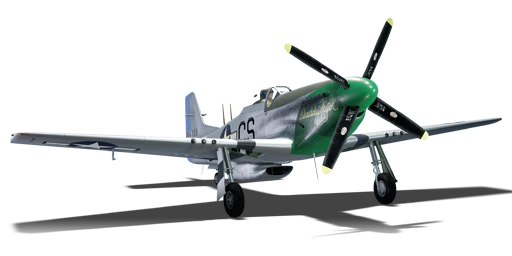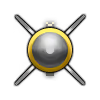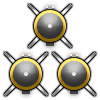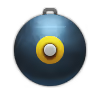


The P-51D-10 is a premium gift American fighter. It was introduced as a premium pack as the P-51D Daddy's Girl in Update 1.70.1945 "Weapons of Victory". It was removed from the Gaijin store in May 2016. It was obtainable in-game with Warbonds in January 2017 and July 2017. It was then added to the Steam store in November 2018 and removed in January 2020. In parallel, it was made available for purchase briefly in the Gaijin store once or twice a year for seasonal sales or recurring events from 2016 to 2022. For example, it was made available for purchase in-game with Golden Eagles for the 2021 "US Air Force Day" and the 2022 "US Air Force Birthday" mini-events.
This P-51D-10 model is based on the plane flown by Ray S. Wetmore, an American WWII fighter ace who is credited with destroying 21 German aircraft. The D-10 variant is only different from the D-5 in that it has a dorsal fin on the tail, the first of the P-51 models to do so.
The P-51D is best flown as boom & zoom fighter and bomber interceptor. Its impressive speed and armament can give experienced players quite the advantage over enemy fighters. The aircraft also performs surprisingly well in the role of an attacker/light bomber.
flaps
flaps
flaps
brake
| Belt | Belt filling | Armor penetration (mm) at a distance: | |||||
|---|---|---|---|---|---|---|---|
| 10 m | 100 m | 500 m | 1000 m | 1500 m | 2000 m | ||
| API-T/AP/AP/I | 30 | 27 | 20 | 13 | 9 | 6 | |
| AP-I/AP-I/API-T/I/I | 28 | 26 | 18 | 11 | 7 | 4 | |
| API-T/I/AP/AP/AP-I/AP-I | 30 | 27 | 20 | 13 | 9 | 6 | |
| API-T | 28 | 26 | 18 | 11 | 7 | 4 | |
| AP-I/I/AP-I/I | 28 | 26 | 18 | 11 | 7 | 4 | |
| Name | Weight | Slot | ||||||||||
|---|---|---|---|---|---|---|---|---|---|---|---|---|
| 62.8 kg |  |  |  |  |  |  |  |  |  |  | ||
| 3 × | 51.8 kg |  |  | |||||||||
| 49.9 kg |  |  | ||||||||||
| 117.9 kg |  |  | ||||||||||
| 242.6 kg |  |  | ||||||||||
| 500.8 kg |  |  | ||||||||||







 2 x (90 / 220 / 440) %
2 x (90 / 220 / 440) % 
 2 x 166 %
2 x 166 % 

Flight performance | |
|---|---|
Survivability |
|---|
Weaponry | ||
|---|---|---|